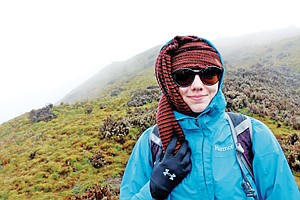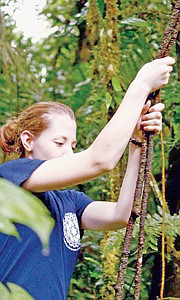Local student travels to Galapagos, Amazon
From her early life in the City of Eagles to Darwin’s finches on the Galapagos Islands, birds have played an important role in Chelsey Oedewaldt’s life.
That’s why Oedewaldt, a 2010 Libby High School graduate, traveled more than 4,000 miles to Ecuador as part of a five-month program studying biology in South America.
By studying different biomes in one of the most geographically diverse countries on earth, she is furthering her career path of evolutionary biology in a big way. Her study-abroad program, one of Pacific Lutheran University’s many offerings, has taken her into the peaks of the Andes to under the canopy of the rainforest and to the rocky shores of the Galapagos Islands. It wasn’t her first time there.
“When I was a freshman in high school, my grandmother took my family on a vacation to the Galapagos,” Oedewaldt wrote in an email from the islands. “I was mildly interested in science then, so it was enjoyable to visit such a historically important place.”
Oedewaldt’s grandmother is a microbiologist, but the 21-year old Chelsey didn’t have her interest in science sparked until high school.
Gene Reckin, a science teacher at LHS, pushed Oedewaldt to find out more about the world around her.
“Biology is an easy class to make interesting,” Reckin said. “We had a big unit on birds and all the specialization they have. I think that hooked her on the world of birding.”
She took some upper-level science courses at in college and decided Ecuador would be the best place for her to do exactly that. The fact that there is a menagerie of birds on the islands certainly doesn’t bother her.
“I love all of the birding opportunities on the islands,” she wrote. “I’ve spent some of my time watching the boobies plunge dive into the ocean. There’s also finches, flycatchers, and mockingbirds to watch. I also like watching the gulls and petrels swim near the ocean or stand on the shore to find food.”
Her current class project is constructing a phylogeny, an evolutionary “family tree,” of Myiarchus, a family of flycatchers.
While Oedewaldt’s program has been accommodating, not everything on the islands has been easy to adjust to.
“Food is a really tough thing for me here,” she wrote. “I really enjoy cooking for myself in the U.S., but I don’t have that opportunity very much here because of the way the meal plan is structured here.”
The language barrier has been troublesome as well, but her Spanish has improved greatly in the short time since she arrived in early January.
Oedewaldt is actually one of two Lincoln County students on the islands (one of 40 overall). Karina Hofstee of Eureka has bonded with the Libby girl over Northwest Montana things during the time on the islands.
The cost of the program is roughly the same as a semester in Tacoma, Wash., so she wasn’t pulling teeth when she told her parents of her desire to go.
Still, it wasn’t easy to let her study in South America.
“My feelings were mixed,” said Carol Oedewaldt, Chelsey’s mother. “It’s a long way from home. It’s definitely a different place. She had to get yellow fever shots.”
The entire time she has been there, Oedewaldt said the most memorable story was when she cried in the Amazon rainforest.
“We went on a night hike in the Amazon,” she wrote. “I don’t particularly like bugs – I can deal with most of the ones in Montana because they are pretty small and benign, but they get kind of crazy in the Amazon.
“My friends and my professors convinced me that I should go, because I probably would never have the opportunity to do it again. I was almost paralyzed with fear before it even started and cried.”
And that was before she started seeing spiders the size of saucers.
She powered through her ordeal and is already gearing up for her next courses.
Even with the culture shock, language barrier and huge spiders, Oedewaldt finds a little piece of home where she can.
“We went on a lot of field trips, including a Paramo ecosystem in the Andes (a cloud forest),” she wrote. “It reminded me a lot of parts of Highway 200 between Libby and Missoula.”






